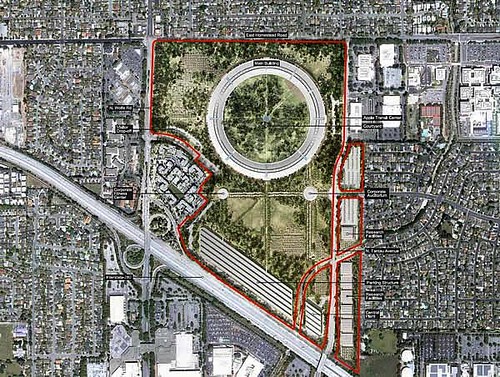If you care about cities, return that new iPad

Posted March 13, 2012 at 1:24PM
If you care about cities, about walkable communities, about healing the crappy environment thrust upon us for the last four decades in the form of suburban sprawl, then get a refund on that new iPad 3. Take your iPhone back, too. Because its manufacturer, oh-so-hip Apple, Inc., is betting that the company is cool enough to get away with violating even the most basic tenets of smart growth and walkability in the sprawling, car-dependent design of its new headquarters. Don’t let them collect on that bet.
While communities all up and down the Silicon Valley are trying to repair sprawl by replacing it with smart growth, Apple is actually taking a site that is now parking lots and low-rise boxes and making it worse for the community. Yes, it will be iconic, assuming you think a building shaped like a whitewall motorcycle tire is iconic, but it will reduce current street connectivity, seal off potential walking routes and, as I wrote some time back, essentially turn its back on its community. With a parking garage designed to hold over ten thousand cars, by the way.
It is essentially the opposite of the great vision of a suburban retrofit that was presented in this space yesterday. The site is remarkably similar, actually. But, while June Williamson and Anne Vaterlaus proposed increased walkability, infill housing, and a street grid on the site, Apple is removing a street and putting up “perimeter protection” to make sure that anyone who might want to ride a bike or walk from point A to point B will have to go around the enormous site.
The definitive synthesis of land use and travel research found that the degree of street connectivity (frequent intersections and blocks sized for foot travel, creating multiple pathways, are best) is the number one indicator of how much walking takes place in a neighborhood. And it’s the number two indicator of how much driving takes place, bringing emissions with it.
While the area is so car-dependent now that I’m sure few people there do much bicycling or walking, that’s not the point: This will be locked in place for thirty, forty, fifty years down the road. A lot of us are hoping current suburbs can be made more sustainable and people-friendly by then, with walkable mixed uses. Everything that Richard Florida and Chris Leinberger have been telling us for the last decade points to a future market that is going to want more, not less, walkable urbanism.
The business community in the currently car-dependent, asphalt-and-low-rise suburb of Dublin, Ohio, believes that the kinds of employees they want to attract are going to demand it. Companies all over the country are abandoning the tired suburban campus model in favor of more urban settings.
Apple seems to think it is hip enough to transcend what most of us want for the future from everyone else, and that the city of Cupertino will be so appreciative of the company’s jobs and tax revenue that high-concept design and the corporate equivalent of a gated community will be more important than trying to cut down on automobile dependence.
The company didn’t have to do it this way. They could have built the site with a combination of corporate offices, new housing (the notorious shortage of affordable homes in the Silicon Valley causes much environmental damage), and neighborhood services. They still could have found a way to secure parts of their offices that need to be secure. If they built enough new units of housing, perhaps they could reduce the hefty amount of corporate parking, because some employees could choose to live nearby and walk. By facing the street, they could have set themselves up nicely for a future transit line.
They could have helped create a real neighborhood by knitting together a district that is currently fractured spatially. They could have made this about the community rather than about themselves. But this isn’t really for the people, see; this is for the one percent. If the Occupy movement had a clue, there would be tents going up in Cupertino right now.
When the new facility was first proposed, Galina Tachieva, author of the Sprawl Repair Manual, criticized it. So did Lloyd Alter of Treehugger. So did the LA Times. So did I. (But one urbanist whom I like very much but who apparently worships at the Church of Steve Jobs actually celebrated Jobs's advocacy for this mistake.) I had some hope that the design would be improved before being formally submitted. Silly me.
I guess I don’t have to like it. But I don’t have to buy Apple's products, either.
Move your cursor over the images for credit information.
Please also visit NRDC’s Sustainable Communities Video Channel.


